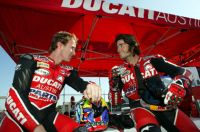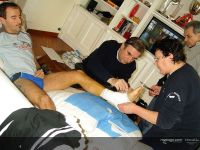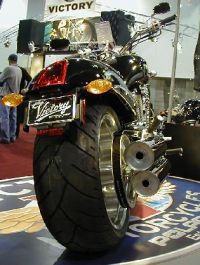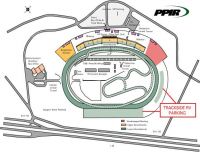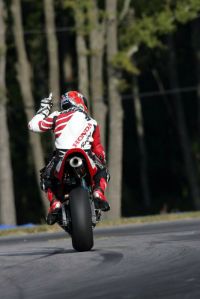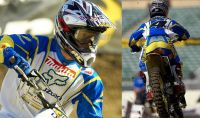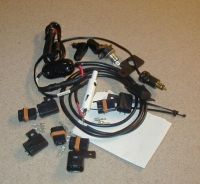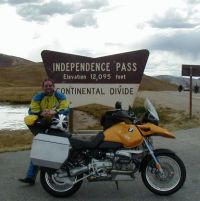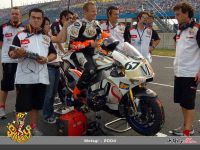The end of the Ducati curse…
Author: site admin
Category: AMA Superbikes
March is just around the corner and it is always a rough time of the year for the Ducatisti. Like the long suffering Boston Red Sox fans, the die-hard race fanatics who cheer for Team Bologna generally find March a month they’d rather just skip. Success at the Daytona International Speedway has been a rare thing for the big red Italian twins, so rare in fact, that there hasn’t been much to cheer about after an AMA Superbike race at the Speedway in nearly 30 years.
In the 90s, Fast by Ferracci tuned Ducati’s ruled the AMA Pro Twins class and even more recently, Ducati 748s have won in Pro Thunder but in the premier class, the last time Ducati stood a top the podium at Daytona was 1977. When you consider that Ducati virtually ruled the AMA Superbike class in the nearly 90s with riders like Doug Polen and Troy Corser, the length of their drought at Daytona comes as a shock. Especially when you look at their success in practice and qualifying for the past decade it seems strange that there hasn’t been a win. Maybe there is a Ducati Daytona curse!
Well, if there is a curse, then like the miracle Red Sox of this past baseball season, this may well be the year that Ducati gives it the smackdown. First, they have a solid team line-up. Second, they have an excellant bike. Third, they are on the “spec” Dunlop tires.
Their favored rider has to be Brit Neil Hodgson racing over here after a dismal season in MotoGP. Despite not having ridden at Daytona since the 90s, Neil was one of the fastest riders during the recent tire tests on the newly reconfigured Daytona track. The guy is a past World Superbike and British Superbike champion, so there is no denying his talent. Additionally, as recently as 2003 he was riding a Ducati 999 and as recently as 2002 was on Dunlop tires so he should have no trouble adapting to his 2005 ride. The only question mark for Neil is how quickly can he adapt to racing next to Daytona’s threatening concrete walls after so many years of racing on world class tracks.
Also a potential threat at Daytona this year is Eric Bostrom. He is into his second season now riding the Duc 999 and is now back on his favorite Dunlop tires after a season to be forgotten on the Michelins. The 999 doesn’t have the same level of front end feel of the Kawasakis upon which Eric was so amazing, so the real question is whether he will finally have gotten that under control. Still, Eric was pole sitter at Daytona last year and ran well until a claimed busted oil cooler ended his shot at winning.
The 999, while definitely finicky, is a proven race winner which has dominated World Superbike since its introduction in 2003. The bike Hodgson and Bostrom will be racing is based on a limited production model, homologated specifically for racing in the AMA series, so it will probably be the most powerful and race focused bike on the grid.
All of the factory teams in AMA Superbike are running Dunlop tires this year which means no more wondering who has the good tire and who doesn’t. While Michelin makes a good tire they don’t have the history in the US that Dunlop have, so there was always a question mark in that regard. No only will everyone be Dunlops but ll the top factory riders will have access to the same choice of tires so there won’t be some guys with a special “A” tire and others with something more mundane. Additionally, Dunlop has said there will be no qualifying tires this season, so fast race time will be set on soft race tires. No more one lap wonders. Neil’s fast times at the tire test are an indication that the Duc doesn’t need ‘em to throw down fast laps.
But perhaps the best card in the Ducati Austin team’s hand this year will be the change in the Superbike race itself. After years of the premier Superbike class running 200 hard miles at Daytona, this year it is being relegated to a 45 mile sprint race while Formula Extreme takes over the prestige of the 200 mile race. Historically, reliability has been the Achilles’ heel for the Ducati during the 200. Whether it is an obvious failure (Gobert’s 2003 race, Picotte’s 2002 race, Mladin’s 1997 race), crashes (Bayliss in 2000, Russell in 2001) or apparent bad luck (Bostrom’s 2004 problem) Ducati have been unable to run at nearly full throttle for the two hours required by the Superbike race at Daytona. This history of failure is in sharp contrast to their qualifying results. In the 90s, Ducati took nearly half of the Daytona pole positions and this was during the reign of Scott Russell as “Mr. Daytona”. I suspect Ducati is near 50% in poles over the past two decades. The big V-twin certainly has the power and in many ways Daytona may be a “Ducati track”. With Superbikes only running a 15 lap sprint race this year, perhaps they can dodge the reliability bullet and finally win one.
Isn’t it about time this curse, like that of the famed Bambino, is finally put to rest?
[image from Ducati web site.]
